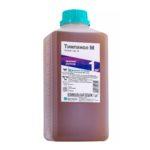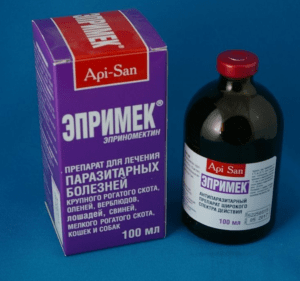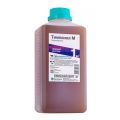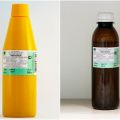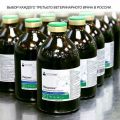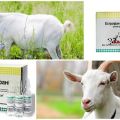How to treat goats with Tympanol and instructions for use, dosage and analogues
An improperly formulated diet often leads to disruption of the goat's gastrointestinal tract. One of the most dangerous diseases of the digestive system is the tympanic scar. Stopping the work of a vital organ threatens the pet with death. The "Tympanol" remedy will help to avoid a sad event, and detailed instructions on the use of the drug for goats will help to understand the treatment regimen. The medicine contains natural ingredients and is safe for the horned beauty.
The composition and form of release of the veterinary drug
Timpanolum is the international name for an emulsion made from medicinal plants. The medicine contains an extract of hellebore lobel, wormwood and lactic acid. Aerosil, distilled water, polyvinyl alcohol and organosilicon antifoam are included in the composition of "Tympanol" as additional substances.
The drug is made in the form of a homogeneous mass of greenish-yellow color. It has an unpleasant, specific smell. The medicine belongs to the means for the treatment of diseases of the gastrointestinal tract of animals.
"Tympanol" is available in glass and plastic bottles in 200 ml packaging. The natural remedy does not pose a threat to human and animal life. According to official data, the drug belongs to the 4th hazard class (Source - GOST 12.1. 007-76).
The main properties of "Tympanol":
- Suppresses fermentation and gas formation. Improves the microflora in the intestines.
- Enhances the production of gastric juice.
- Destroys pathogens.
- Induces vomiting. Restores the frequency of scar contractions.
- Chops up pieces of undigested food and removes it from the body.
- Strengthens peristalsis.
- It has a foam suppressing effect.
- Relaxes the sphincters of the stomach. This speeds up the movement of food in the intestines.
- Destroys the smallest gas bubbles contained in succulent feed.

Indications for using the product
A natural drug is prescribed for an outbreak of a disease called tympanic scarring. The disease is a mortal danger for the pet. The disease occurs due to poor quality food or the predominance of concentrated feed in the animal's diet.
The gastrointestinal tract of a goat is arranged in a cunning manner. It consists of 4 parts (scar, mesh, oma and abomasum). First, the eaten food enters the "reception" of the digestive system - the rumen, where the food is processed by enzymes. By contracting, the scar crushes food and directs it to other parts of the gastrointestinal tract. There the feed is regurgitated, re-grinded and processed using special bacteria and enzymes.
A sophisticated system allows the goats to digest large amounts of plant food. Termination of the rumen poses a danger to animals. As a result of atony, the goat cannot regurgitate food, so the contents of the rumen rot and ferment.
Due to the increased gas production, an important part of the digestive tract swells and constricts the intestines. If the animal behaves nervously, constantly looks back at the belly, often wags its tail, the owners should be wary.
Shallow breathing and swelling in the abdomen are other signs of the disease. If you let things take their course and do not treat the pet, the goat may die.
Instructions for using "Tympanol" for goats
"Tympanol" is administered through the mouth of a goat. The procedure is carried out using a rubber bottle or a special probe. Through the esophageal tube, the drug is injected directly into the rumen cavity. In emergency cases, the emulsion solution is injected through the area of the hungry fossa using a surgical trocar. This procedure is performed only by an experienced veterinarian.
How to prepare a medicine for use:
- The drug in the bottle is shaken thoroughly.
- The emulsion is diluted with water in a ratio of 1:10. For the treatment of mild cases of the disease, the medicine can be diluted at the rate of 1 part of the drug to 15 parts of water.
- Measure the required amount of solution. The dosage is calculated according to the formula: 0.5-1 ml of the drug per 1 kg of animal weight.
- If there is no improvement within a quarter of an hour, it means that one dose of Tympanol is not enough. You will have to dilute the emulsion with water again and repeat the procedure.

Due to its natural composition, the medicine can be easily combined with other drugs. Dairy products obtained from a goat during the period of illness and treatment can be used without any restrictions.
Safety engineering
"Tympanol" does not belong to hazardous substances, therefore, when using the product, general safety rules are observed. It is necessary to adhere to the exact dosage of the drug and ensure its storage conditions. After working with the emulsion, wash your hands thoroughly with soap.
If drops of the drug do get on an open area of the body, it is necessary to wash the skin with soap and running water. If you feel worse, you should immediately consult a doctor.
Contraindications and side effects
"Tympanol" consists of natural ingredients, so the occurrence of side effects is unlikely. The only contraindication to taking the drug is personal intolerance to the individual components of the drug by animals.

How to store the drug correctly
A dry, dark place is chosen to store the medicine. The drug is hidden away from curious children, food and animal feed. At storage temperatures from 0 to 20 degrees, "Tympanol" does not lose its healing properties for 1.5 years. After the expiration date, the drug is disposed of.
Similar means
The domestic remedy "Atympanol" is used as a substitute for the drug. In terms of its composition, the drug differs little from the original emulsion. Experts only slightly changed the proportions of active ingredients and added vegetable oil to the preparation.
If necessary, "Tympanol" is replaced with tinctures of bitter wormwood or hellebore. Lactic acid has similar properties. However, herbal tinctures cannot fully replace the drug.



